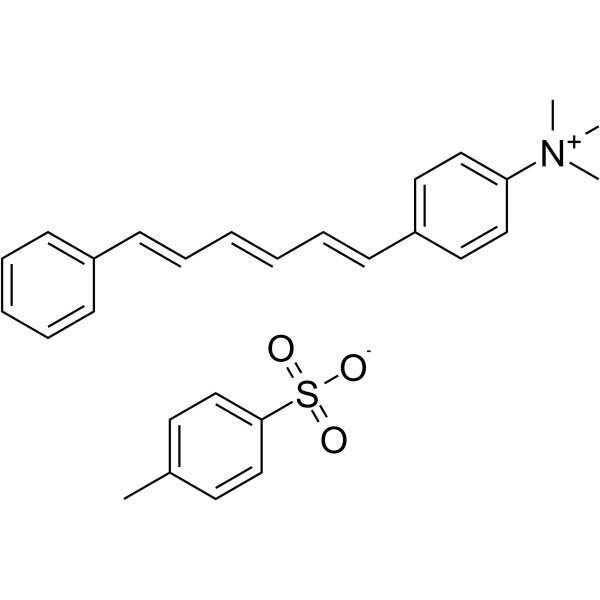All AbMole products are for research use only, cannot be used for human consumption.

Tma-dph contains a cationic trimethylammonium substitute that can be used as a surface anchor locator to improve the localization of the fluorescent probe DPH in the membrane. By analyzing the fluorescence polarization values of TMA-DPH in the plasma membrane and membrane substructures, the fluidity of the cell membrane can be determined. The maximum excitation/emission wavelength is 355nm/430nm, and it is blue fluorescent and stored at room temperature away from light.
*The compound is unstable in solutions, freshly prepared is recommended
| Molecular Weight | 461.62 |
| Formula | C28H31NO3S |
| CAS Number | 115534-33-3 |
| Solubility (25°C) | DMSO 6 mg/mL |
| Storage | -20°C, protect from light, dry, sealed |
[2] Brad Chazotte. Cold Spring Harb Protoc. Labeling the plasma membrane with TMA-DPH
| Related Fluorescent Dye Products |
|---|
| PGSK diacetate (5/6-mixture)
PGSK diacetate (5/6-mixture) is a metal ion-sensitive fluorescent probe that can penetrate cell membranes. PGSK diacetate can react with a variety of metal ions, including Fe2+, Cd2+, Co2+, Ni2+, Zn2+, etc. PGSK diacetate chelates Fe2+, resulting in fluorescence quenching, which can be restored when a membrane-permeable chelator is added, thereby reflecting the changes in the intracellular chelatable iron pool. The excitation/emission maxima of PGSK diacetate are 507/532 nm, respectively. |
| Dextran-Rhodamine B
Dextran-Rhodamine B (RB-Dextran) is a fluorescent marker made by combining rhodamine B fluorescent dye and dextran polysaccharide through a specific chemical reaction. RB-Dextran is a red fluorescent modified dextran polysaccharide formed by chemically labeling rhodamine B onto dextran molecules, which can be used in cell tracing, biofluid dynamics research and other fields, and its fluorescent properties can be used to track the distribution and metabolism of dextran in organisms and other processes. |
| N-Succinimidyl 6-(2,4-Dinitroanilino)hexanoate
N-Succinimidyl 6-(2,4-Dinitroanilino)hexanoate, the DNP-X acid modified by succinimidyl ester, is an amine-reactive building block for developing a probe, which can be recognized by anti-DNP antibodies. |
| FITC-Arachidonic Acid
FITC-Arachidonic Acid is a fluorescent labelled compound for biomedical research. FITC-Arachidonic Acid combines the biological activity of arachidonic acid and the fluorescent properties of FITC, and is suitable for the study of cellular signalling, lipid metabolism and so on. |
| Arachidonic acid-biotin
Arachidonic acid-Biotin is a biotin-labeled Arachidonic acid that can be used to detect complexes of arachidonic acid with protein binding partners such as fatty acid binding proteins (FABPs). |
All AbMole products are for research use only, cannot be used for human consumption or veterinary use. We do not provide products or services to individuals. Please comply with the intended use and do not use AbMole products for any other purpose.


Products are for research use only. Not for human use. We do not sell to patients.
© Copyright 2010-2024 AbMole BioScience. All Rights Reserved.
